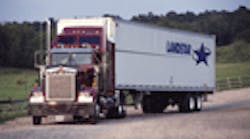Overall, carriers are reporting strong gains in revenues and earnings for the second quarter this year, with expectations that this trend should continue despite a softening of the U.S. economy.
“I would characterize the overall second quarter freight environment as a little choppy, but moving in an upward direction [while] pricing continued to be strong,” noted Henry Gerkens, chairman, president & CEO of Landstar System Inc., in the company’s quarterly earnings report.
Despite that “choppiness,” though, Landstar posted net income of $29.6 million on revenues of $675.6 million in the second quarter, compared to net income of $24.4 million on $541.7 million in revenues during the same period last year – contributing to a 27% jump in earnings per share, which Gerkens’ described as “the best second quarter earnings per share [62 cents] in Landstar history.”
He added that “recent trends in June, and thus far in July, indicate continued strength in revenue per load with a relatively stable increase in the number of loads hauled month over prior year month. I expect these trends to continue throughout the third quarter.”
“Despite a relatively soft freight environment in the first six weeks of the quarter, we nearly tripled our earnings excluding the effect of last year’s fuel hedge gain, which amounted to approximately $1.2 million pretax,” noted Cliff Beckham, president & CEO of USA Truck.
The carrier’s net income slipped a bit to $600,000 on 14.3% higher revenues of $108.5 million in the second quarter compared to net income of $900,000 on $94.9 million in revenue in the same period last year – largely due to rising costs tied to a growing driver shortage.
“Our customer, lane and load selection continued to improve, partially offset by increased driver-related costs,” Beckham said in USA Truck’s second quarter report. “The major impediment to greater earnings in trucking was a lack of qualified drivers. Driver compensation costs increased nearly 3 cents per mile and driver recruiting and training costs also increased by 20%. “
Overall, USA Truck said some 9.1% of its fleet remained unmanned during the second quarter compared to 6.5% last year, and the company hopes to drive that down to 3%.
That’s just part of a volatile mix of issues affecting bottom line costs and pricing strategies within the TL sector of the industry, noted H. Peter Nesvold, an equity analyst for investment firm Jeffries & Co.
“In TL we estimate that dry van pricing – revenue per mile net of fuel – increased roughly 4% year-over-year (yoy) in the second quarter on flat to low-single digit type freight volume growth,” he explained. “We see most of the yoy pricing gains in the long-haul segment, while we expect short-haul rates grew a more muted 2-4% yoy net of fuel.”
While he said the “TL pricing renaissance has generally not played out during 2011 as many had called for,” he remains optimistic that carriers can gain mid-single-digit pricing increases in 2012.
“That is, we anticipate that further pricing gains next year in a range of 4-6% might be achievable on low-single-digit volume growth due to the threat of a looming driver shortage – and thus higher driver pay – a combined productivity hit from CSA and HOS [hours of service] reform of between 5 to 10%, rising tire and battery prices, incrementally higher equipment costs, and reluctance to commit capital to additional capacity.”



